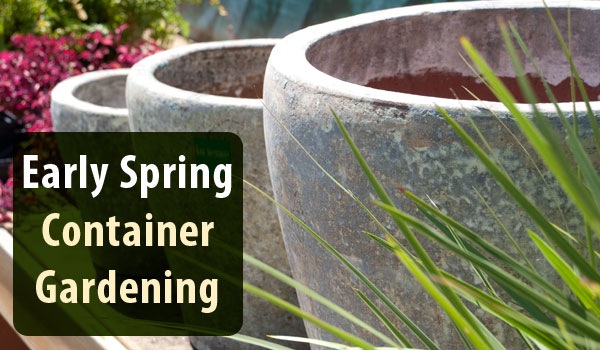Early Spring Container Gardening
Story by Lindsey Chester. Photo by Hal Goodtree.
Cary, NC- Finally Spring is here, but the ground is still not warm enough to accept plants. Gardeners can satisfy that urge to plant by purchasing smaller specimens and placing them in ornamental containers that also offer flexibility with placement throughout the garden.
I started planting in containers when we lived in an apartment that had a wonderful patio and porch. Containers offer flexibility. Plants can be moved if light conditions change or if the bloom season is past.
First Things First
Make sure your containers have adequate drainage holes. Plants cannot sit in soggy water logged soil or they will rot. Water should be able to run through the bottom. But to sure the water flows out and not the soil, place coffee filters, or fine mesh across the bottom.
Soil
A good loamy potting soil is a must, and I prefer soil with added fertizer (like a Miracle Grow Potting Soil) as it saves me a step. If the soil is not already fortified, now is the time to add some fertilizer and mix in well. Plants need good drainage and nutrients to thrive, and soggy and depleted soil will lead to root rot and starved plants!
Note the Location
Think about where you want your containers to live – beside the front door, filling in an area of a deck or patio, up by a mailbox or beside a seating area. Then consider the light the area gets to be sure you select the correct plants for that situation.
Planning
Two things to consider:
- Mixing several varieties of plants in one container
- One species per pot and then grouping containers
Mixed Pots
When planting a mixed pot, be sure that all the plants like similar conditions. If the area is sunny, be sure each plant can handle full sun (or part shade etc). Don’t mix a shade loving coleus with a sun loving dahlia. One will be unhappy and keel over before you know it!
Another thing to consider within one pot is variety of heights and growing habits. Often in garden centers I admire the mix of plantings, thinking the designer is painting with plants. Looking for contrasting shades from one species to the next, and vary the plant heights.
For a really pleasing selection I pick 3 different heights per pot. First select a low growing or trailing plant. Think of this one as your base. Creeping Jenny, Pennyroyal, sweet potato vine and various ivies are great base plants.
Next pick something with some height and presence- holly hocks, and ornamental grasses will give your pot some structure.
Last pick a some plants that are “fluffy” and medium sized. These can be lambs ears, begonias,
Planting
I like to mix up a big barrel of water with some Miracle Grow. Place the nursery containers in there, up above the soil line for a good soak before removing the plants from them. This process ensures that the plants are well watered and nourished before they are transplanted. They are also easier to remove.
Make sure you have filled your new container halfway with good potting soil. Then place your selections gently remove your new plants from their nursery packs. Loosen and pinch them out from the bottom. Never pull them out by the stalk.
Place the un-potted plants in a pleasing arrangement in the pot before adding more soil. Add the soil a spadeful at a time around the root balls, being careful to keep the soil level of the plant the same as it was it its nursery pack. Filling in around the plant and patting down gently.
Lastly, deeply water your new container after everything is in place. Allow to dry before watering again. But remember, containers need to be watered more frequently than plants in the ground, especially if the pots are clay, which wicks water away and dries out quickly (Try NOT to use these if you can avoid).
Then enjoy a season of loveliness. And remember, you can move containers around easily as the season progresses in your garden.
————————————————————————————————————–
The Gardening Column on CaryCitizen is sponsored by Garden Supply Company on Old Apex Rd. in Cary, NC.




Comments are closed.